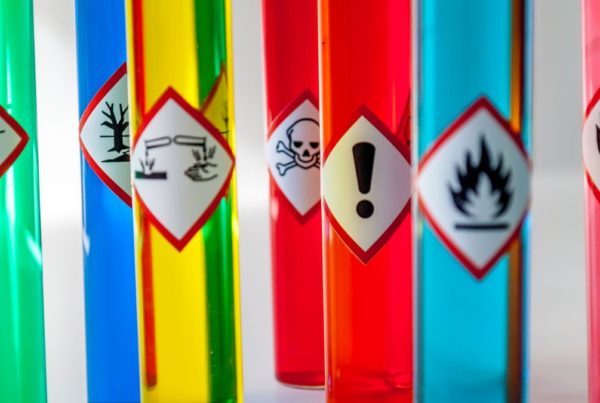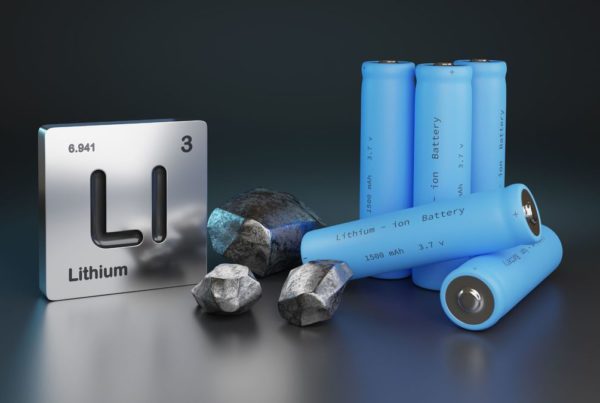The correct disposal, storage, and treatment of hazardous wastes depend on the types of hazardous waste you deal with in the course of your work. For example, discarded commercial chemical products are a fairly obvious kind of hazardous waste, but even things like cell phones and contaminated soil can be subject to hazardous waste management laws.
If you create hazardous waste as part of your cultivation, manufacturing, or laboratory operation, it’s important to understand the different hazardous waste types to help you create an appropriate hazardous materials business plan.
Characteristic Wastes
The Environmental Protection Agency (EPA) defines four characteristic hazardous wastes. These characteristics, as laid out in the Code of Federal Regulations (40 CFR), are:
- Ignitability.
Examples of ignitable wastes are gasoline, butane, propane, and kerosene.
- Corrosivity.
Examples of corrosive wastes (including Class 8 hazardous materials) are sulfuric acid and hydrogen peroxide.
- Reactivity.
Examples of reactive hazardous wastes are pressurized aerosol cans, which can explode; and lithium-sulfur batteries, which can release toxic gasses.
- Toxicity.
Examples of toxic hazardous waste include pesticides, solvents, and heavy metals like mercury and lead.
Substances with More than One Hazardous Characteristic
To be considered hazardous, a substance only needs to have one of the EPA-defined characteristics (ignitability, corrosivity, reactivity, or toxicity). However, some substances have more than one hazardous characteristic. The butane used in cannabinoid extraction, for example, is both ignitable and toxic waste.
Disposing of a Substance that Includes Multiple Types of Hazardous Waste
When more than one hazardous characteristic is present, the generator needs to follow the hazardous waste storage and hazardous waste transportation regulations for all of the hazardous characteristics of the waste.
For example, in the growing cannabis industry, businesses commonly deal with products like vape pens, which contain both lithium-ion batteries and residual cannabis oil (both subject to different hazardous/special waste regulations). A hazardous cannabis waste management company is almost always necessary to help these types of businesses remain in compliance. The same holds true for other types of businesses that deal with complex hazardous materials.
Listed Waste
In addition to establishing hazardous waste categories based on their characteristics, the EPA separates hazardous wastes into streams based on how they are produced. Substances that are listed in one of the four streams (F, K, P, and U) are referred to as “listed wastes.”
- F list wastes are produced as part of industrial and manufacturing processes.
- K list wastes, like pesticides, have a specific designated purpose.
- P list wastes are acute hazardous wastes that mostly comprise unused and discarded commercial chemical products.
- U list wastes are discarded commercial chemical products that are often unusable and are generally less toxic than P list wastes.
Universal Waste
Universal wastes are kinds of solid household waste that can be dangerous if they’re thrown in the regular trash. There are five categories of universal solid waste:
- Aerosol cans
- Bulbs and lamps
- Batteries
- Mercury-containing goods
- Unused pesticides
Local councils often arrange pickup or delivery points for universal wastes to make proper disposal more convenient. If no local pickup or drop-off point is available, you may need to take these items to your nearest hazardous waste handling facility or arrange pickup with a permitted hazardous waste transporter.
Mixed Waste
Mixed waste materials may or may not constitute a type of hazardous waste. In California, for example, a mixture containing an M-listed waste or one that is derived from an M-listed waste is only considered hazardous waste if the mixture exhibits a characteristic of hazardous wastes (see 22 CCR section 66261.3(b)(4) and (c)(5)).
Contaminated Media
Soil, surface water, and groundwater may be considered hazardous wastes if they become contaminated with hazardous substances. For example, contaminated wastewater from irrigation may be considered hazardous waste because of the pesticides “contained in” the water.
Electronic Waste
Electronic waste or e-waste is another type of hazardous waste that requires proper disposal to protect human health and the environment. Some of the components in computers, tablets, cell phones, refrigerators, televisions, printers, and toasters can cause a fire or leach into the soil if thrown in the regular trash. However, with proper recovery and recycling, many electrical components can be used again.
Mixed Radioactive Waste
Radioactive waste from nuclear research, medicine, power generation, weapons, and rare-earth mining is a type of hazardous waste that is regulated by the Department of Energy and the Nuclear Regulatory Commission rather than the EPA. If a waste material contains both radiological and hazardous components, it must be disposed of in accordance with both the Resource Conservation and Recovery Act (RCRA) and the Atomic Energy Act (AEA).
Excluded Hazardous Wastes
Finally, there are types of hazardous waste that are excluded from hazardous waste disposal regulations. This is usually because they are not in contact with the environment or because they are regulated under a different law.
One example of excluded hazardous waste in California, according to 22 CCR section 66261.4 – Exclusions is the source discharge of industrial wastewater. In this case, the wastewater discharge is regulated under section 402 of the federal Clean Water Act and amendment 33 U.S.C., section 1342. The exclusion does not apply to the collection, storage, or treatment of the wastewater before discharge. The exclusion also doesn’t apply to industrial wastewater treatment sludge.
What to Do with Hazardous Waste
Once you’re familiar with the different types of hazardous waste, you can list the types of hazardous waste that you generate and find out which regulations apply to those types of hazardous waste.
In many cases, the best way to handle hazardous waste recycling and disposal is to find a specialized hazardous waste management company that can guide you through the process of labeling, storing, and arranging for the collection of your hazardous waste.
When it comes to safety and compliance with hazardous waste, it’s important to get it right. And once you know which types of hazardous waste you’re dealing with, it’s much easier to find the right waste management service for your needs.






